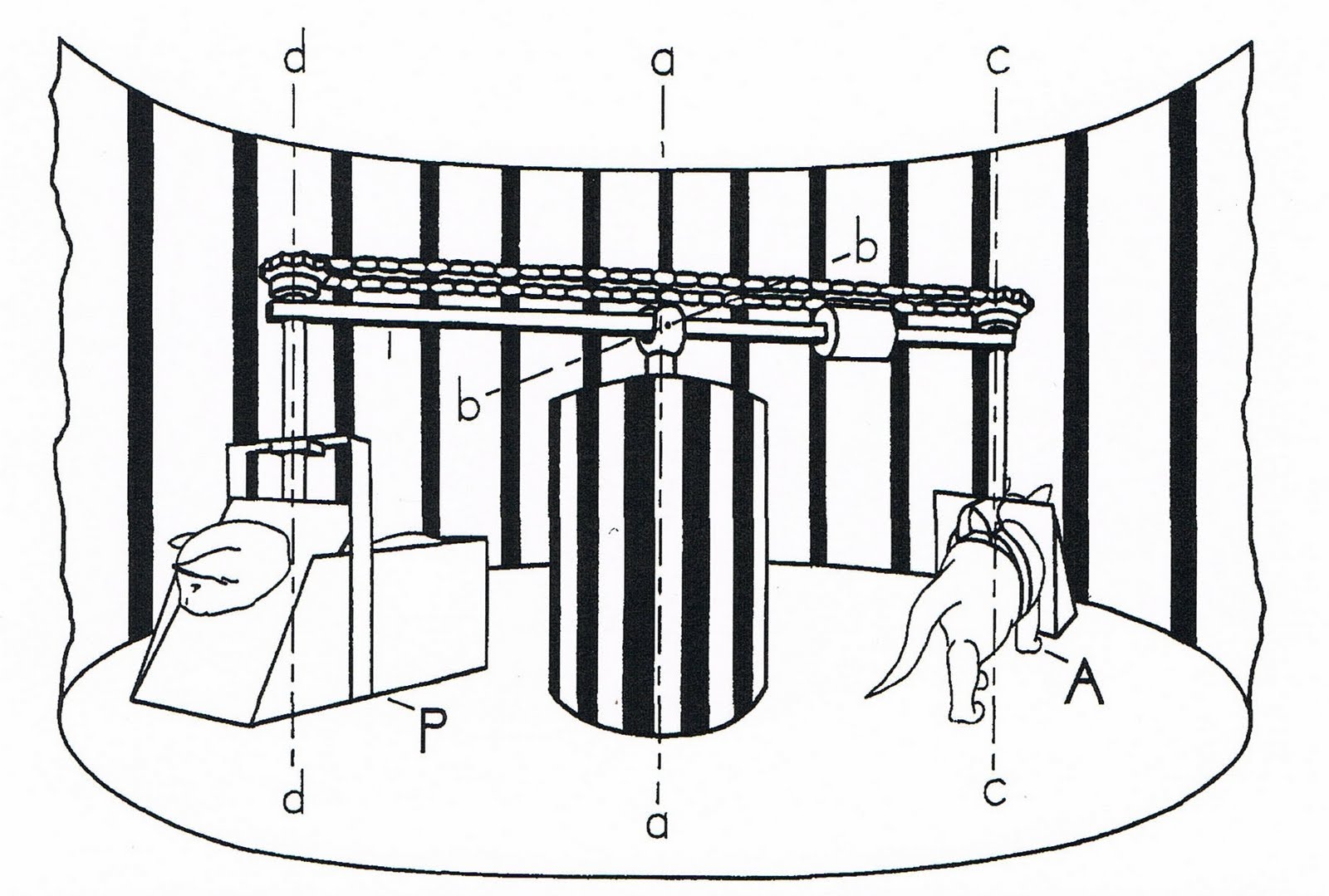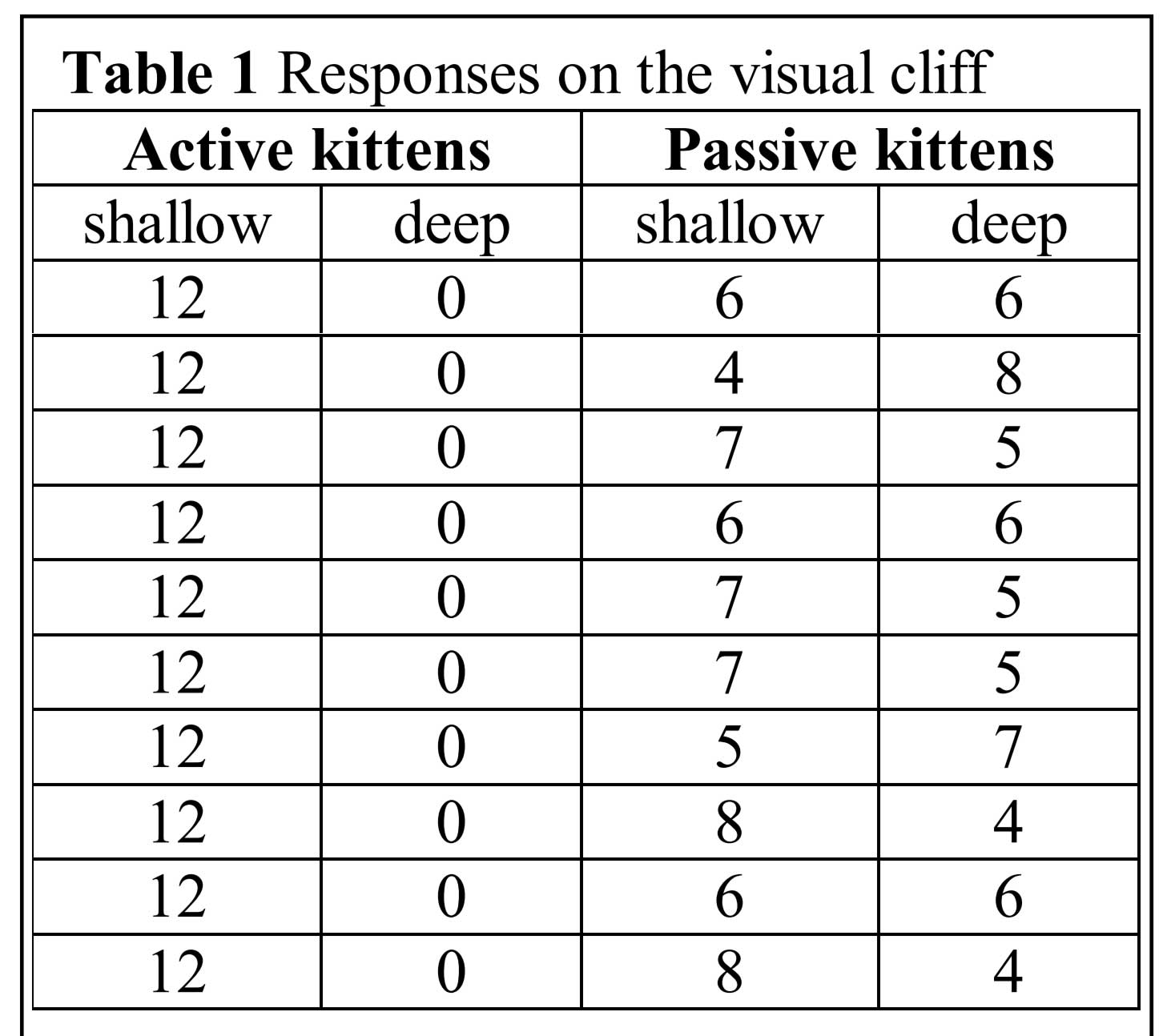On This Page:
Held, R., & Hein, A. (1963). Movement-produced stimulation in the development of visually guided behavior. Journal of Comparative and Physiological Psychology, 56 (5), 872.
Previous evidence from two sources suggested that the way the visual world was interpreted could change, ie that there is a degree of plasticity in the neural systems responsible for perceptual development.
Firstly, restricting the visual experience of newborn animals (neonatal deprivation) affects the development of spatial perception and coordination – as demonstrated, for example, by Reisen & Aarons (1959) and Reisen (1961).
Secondly, adult human perception also displays some plasticity as people can adapt to new perceptual information. Held (1955) demonstrated this adaptation experimentally with auditory information (sound), and Held & Hein (1958) with visual information.
In addition, case studies of adaption to inverted images (e.g., Stratton, 1897) and of people who have recovered their sight after being blind for many years (e.g., Gregory & Wallace, 1963), suggest that adult human perception is plastic.
Aim
One unanswered question was the extent to which this adaptation relied on ‘concurrent self-produced movements,’ i.e., whether the individual needed to move around at the same time as experiencing visual changes in order to acquire perceptual skills.
The aim was therefore to test whether being moved around and seeing the environment change was sufficient to develop visually guided behavior, such as depth perception, or whether the individual needed to experience self-generated movement in order to learn.
Procedure
- Independent variable: the condition of the kitten: active or passive.
- Dependent variable: the perceptual skills and development of the kittens.
Ten pairs of kittens were used, each pair from a different litter (Aged between 8 and 12 weeks). In each pair, one was ‘active’ (A) and one was ‘passive’ (P).
During exposure to the visual environment, the kitten pair was attached to a freely-moving ‘roundabout’ which was propelled by the movements of kitten A because its body was firmly but flexibly attached to the apparatus.
This animal could:
- rotate clockwise or anticlockwise around the center
- go towards or away from the center (i.e., out to the edge or back in)
- move up or down (e.g., stretch up or crouch down) turn left or right.

Kitten P was also firmly attached to the roundabout but it was carried in a basket, so it could not control its own movement. Through a mechanical system, kitten B was moved in exactly the same way as kitten A.
So if kitten A walked clockwise, moved to the edge, then back to the center, then moved upwards and dropped down again, so did kitten P. Kitten P’s legs stuck through the bottom of the basket, so although he could not move them, they could slide along the floor as he moved.
Neither kitten could see their own limbs, although both could move their heads freely.
The apparatus was housed in a cylinder with black, white, and metal-colored vertical strips on the walls inside. The center of the roundabout, which was also striped, prevented the kittens from seeing each other.
The pairs spent 3 hours per day in the experimental apparatus, beginning when the active kitten was big enough to move the ‘roundabout’ and continuing for six weeks. When not in the experimental apparatus, all kittens were housed in darkness with their mother and littermates.
The kittens’ perceptual abilities were tested in an illuminated laboratory. There were three tests of visually guided behavior:
- Visually-guided paw placement: the kitten was held by the experimenter with its head and forelegs free and was carried down to the edge of the table. A kitten with normal visual experience extends its paws, ready to make contact with the surface.
- Avoidance of a visual cliff: the kitten is placed on the central ‘bridge’ from which it can stay still or walk onto either the ‘shallow’ or ‘deep’ side. A kitten with normal visual experience avoids the ‘deep’ side.
- Blink to an approaching object: the kitten was held still in a standing position and the experimenter brought his hand quickly towards the kitten’s face (stopping just in front of it). A kitten with normal visual experience blinks in response.
In addition, three tests of visual receptors and their responses were conducted:
- Visual pursuit of a moving object: the kitten was shown the experimenter’s hand moving slowly in front of it. The movement of the kitten’s eyes was recorded. A kitten with normal visual experience follows the movement with its eyes.
- Pupillary reflex to light: a torch beam was moved across the eye and the change in pupil size was noted. The pupil of a kitten with normal visual experience shrinks in response.
- Tactual placing response: the kitten was held as in the paw placement test but its front paws were put against the vertical surface of the table. A kitten with normal visual experience responds by moving its paws to the horizontal surface.
Findings
All of the active kittens had developed a normal visually-guided paw placement response when they had spent 63 hours (21 sessions) or less in the apparatus, most by about 33 hours (11 sessions).
After an equivalent length of time to their active littermate, no passive kitten had acquired a visually-guided paw placement response.
The same pattern was seen with the blink response, which appeared at the same time as the visually-guided paw placement response. On the same day as each kitten
A demonstrated the visually-guided paw placement response. The pair was tested on the visual cliff (and the next day). The results of these tests are shown in Table 1.

They show that all of the active kittens had normal responses to depth but the passive kittens were crossing to the shallow or deep side at random. This suggests that they were unable to discriminate between the deep and shallow drops.
However, a sub-group of two passive kittens had been given an additional period of passive stimulation in the apparatus between 2 and 10 weeks of age.
When given an extra two days in the light and then re-tested, these two kittens rapidly developed normal visually-guided paw placement and visual cliff responses.
Normal visual pursuit of a moving object, the pupillary reflex to light, and tactual placing responses were seen in all animals when tested immediately before being placed in the apparatus for the first time.
Conclusion
The findings fit the idea that self-produced movement and concurrent visual feedback are essential for the development of visually-guided behavior.
Critical Evaluation
Held & Hein observe that there are possible alternative explanations for their findings. One is that the deprivation could have led to some anatomical or physiological loss (atrophy) which was causing the passive kitten’s perceptual deficits.
This is unlikely, however, as they showed normal physiological responses (in the three additional tests). Furthermore, it would be unlikely that such a minimal recovery time for the sub-group of passive kittens could overcome any such damage.
They also discount the possibility that the problems are purely physical or behavioral – since the kittens could perform the tactual placing response normally.
Another criticism suggests that the differences could have been due to emotional responses caused by the release from deprivation during testing.
However, Held & Hein suggest that this cannot be the case because the restriction of the P and A kittens was so similar.
Furthermore, there was no apparent difference between the P and A kittens in terms of their fear or excitement in response to the novel situations.
References
Gregory RL & Wallace JG (1963) Recovery from early blindness: a case study, in RL Gregory (ed) Concepts and Mechanisms of Perception (1974), pp 65-129. London: Duckworth.
Held R (1955) Shifts in binaural localization after prolonged exposures to atypical combinations of stimuli. American Journal of Psychology, 68: 526-48.
Held, R., & Hein, A. (1963). Movement-produced stimulation in the development of visually guided behavior. Journal of Comparative and Physiological Psychology, 56 (5), 872.
Held R & Hein A (1958) Adaptation of disarranged hand-eye coordination contingent upon re-afferent stimulation. Perception & Motor Skills, 8: 87-90.
Reisen AH & Aarons L (1959) Visual movement and intensity discrimination in cats after early deprivation of pattern vision. Journal of Comparative Physiology & Psychology, 52: 142-9.
Reisen AH (1961) Studying perceptual development using the technique of sensory deprivation. Journal of Nervous & Mental Diseases, 132: 21-5.
Stratton GM (1896) Vision without inversion of the retinal image. Psychological Reviews, 4: 341.

